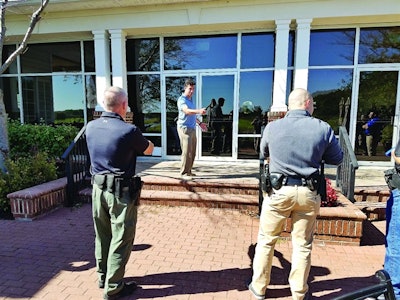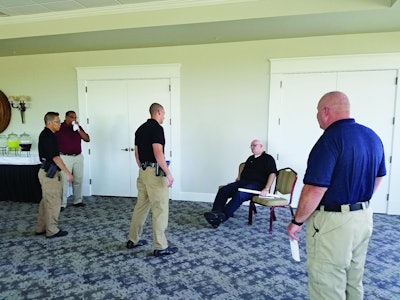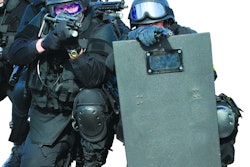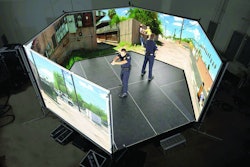
Today's law enforcement officers face confrontations with a wide range of subjects who present dangers to the officers and the community and can be difficult to reach through verbal commands. These people can be experiencing any number of issues ranging from drug reactions, to psycho-medical emergencies, to suicidal desires. And officers now need to know how to communicate with these subjects, when to use force on them, and when to de-escalate situations involving them.
This October, a new de-escalation training methodology was presented to law enforcement administrators, supervisors, and field officers in Delaware that the participants say could become the training model for de-escalation training nationally. It is referred to as the "multidisciplinary de-escalation model."
The multi-disciplinary concept and instructor course was developed by forensic criminologist, certified medical investigator, law enforcement practices expert, and frequent POLICE Magazine contributor Dr. Ron Martinelli. Martinelli is a retired police officer and detective with the San Jose (CA) Police Department and he previously developed a field training program that has been a national model for police agencies since the mid-1970s.
A total of 23 Delaware law enforcement agencies from across the state attended this training. The importance of high-quality de-escalation training for police officers was emphasized by Robert Cope, secretary of the Delaware Department of Safety and Homeland Security and Chief William Bryson, chair of the Delaware Police Chiefs' Council, who introduced the course and instructor to the attendees.
People in Crisis
The multi-disciplinary de-escalation model identifies several components of de-escalation to include: pre-contact threat assessment, officer safety, psychophysiology, and tactical communications.
In the Delaware program, officer-instructors were trained to use a proactive response protocol for psycho-medical emergencies. The protocol incorporates a pre-contact threat assessment phase and a subject assessment and evaluation phase to deal with subjects who exhibit problems ranging from acute mental health disorders, to medical emergencies, drug influence, or suicidality; including subjects who try to lure officers into "suicide-by-cop" scenarios. Instructor candidates also received in-depth information on psychophysiology and how the brain and body either work together, or don't function together, while under the influence of survival chemicals such as adrenalin, endorphins, and dopamine under intense stress.
Cops are not board-certified physicians or psychiatrists trained to make diagnoses, so in this class, they learned how to evaluate and assess various basic psychoses and psycho-medical emergencies. Covered were such issues as agitated-chaotic events, decompensation from patients not taking their psychotropic medications, and what happens when people overdose on their medications. Also covered were such issues as the effects of synthetic cannabinoids, metabolic disorders, viral infections, hyperthermia, dementia, Alzheimer's disease, autism, and suicidal ideations.
In Martinelli's program, officers are taught that when responding to and addressing psycho-medical emergencies—once officer and citizen safety concerns are addressed—the focus should be on treating the subject as someone needing immediate medical intervention, rather than a suspect who needs to be arrested.
 In Martinelli's program, for psycho-medical emergencies officers are taught to treat the subject as someone needing medical intervention, not a suspect. Photo: Martinelli and Associates
In Martinelli's program, for psycho-medical emergencies officers are taught to treat the subject as someone needing medical intervention, not a suspect. Photo: Martinelli and Associates
Reaction and Response
Martinelli says the de-escalation protocol begins with the dispatcher, who should have the latitude to immediately contact and dispatch Emergency Medical Services (EMS) personnel to a staging location nearby. This is so they can be immediately available to medically intervene with a powerful sedative once the subject in question has been captured, controlled, and restrained by police.
Officer safety and pre-contact threat assessment of a bizarrely acting, resistant, and/or threatening subject during an encounter prior to communicating with them are critical components of de-escalation. During the instructor and end-user de-escalation classes, officers learn such human factors concepts as action-reaction perception lag time and the "reactionary gap" formula of distance versus reaction time.
Martinelli's new human factors research in dispelling the outmoded "21-Foot Rule" is also discussed and demonstrated with participants being introduced to the safer and the more efficient "Gun Assault Positioning" (GAP) distance technique. The GAP technique provides responding officers with skills to better assess distances between themselves and high-risk subjects, while avoiding deadly confrontations when they or the involved subject compresses distance and time such as when suicidal subjects attempt to force officers to shoot and kill them during suicide-by-cop incidents.
Participants in both the instructor and end-user de-escalation courses learn various verbal and non-verbal communication skills that have historically proven to be the most successful when dealing with a variety of verbally non-compliant, hostile, and mentally or chemically unbalanced subjects. Officers are taught that the voice and body language must always be in harmony. Early in the classes, officers are taught the concept of officer "emotional capture" and to always have a studied, rather than an emotional response to verbal non-compliance, posturing, anger and hostility. They are also taught how to assess non-verbal threatening gestures which are pre-assault indicators.
Practical Testing
On the second day of instructor certification training, participants undergo competency testing, which consists of a battery of written and performance scenarios. For the performance scenario testing, the instructor candidates are divided up into role players and officer and supervisor responders, briefed on their roles, and cycled through a variety of increasingly challenging scenarios. To maintain the realism of the scenario practicals, all the scripts used have been taken directly from actual officer-involved cases that were previously adjudicated and documented from federal and state litigation that Martinelli has personally worked on. Officer-instructors were trained to use a proactive response protocol for psycho-medical emergencies. Scenarios tested their mastery of the techniques. Photo: Martinelli and Associates
Officer-instructors were trained to use a proactive response protocol for psycho-medical emergencies. Scenarios tested their mastery of the techniques. Photo: Martinelli and Associates
De-escalation instructor candidates quickly learn that de-escalation and force response are a thinking officer's strategy that requires careful consideration as to what non-force and force techniques, tactics, and/or weaponry are available to them based upon the unique challenges of each circumstance with a non-compliant, mentally or medically incapacitated, or potentially violent subject they encounter.
Instructor candidates learn they must become chameleons who quickly adapt to rapidly evolving situations and can improvise effective strategies to overcome resistance and generate voluntary compliance. In the case of serious, dynamic, and high-risk psycho-medical emergencies and/or violent subjects, the officers learn to expeditiously capture, control, and restrain the involved subjects so that EMS can sedate them.
Martinelli says that from the time the instructor candidates first enter the classroom, they are training to adopt the mindset of lifesavers. "The multi-disciplinary de-escalation methodology stresses that saving officer and subject lives is paramount in their encounter objective. The incident response protocol, subject assessment/evaluation, flexibility in strategy, officer safety and issues of preclusion and what happens when words fail are reinforced in the debriefings conducted at every station once the scenario has ended," he says.
At the conclusion of each scenario, the involved subject role players provide insight into whether the situation was handled appropriately and whether alternate strategies might have worked better. Chiefs and field supervisors are also used to reinforce department policies and mission statements. Chiefs also get a look at the changing and high-risk field environment their officers are working in today.
In addition, Martinelli provides insight as to how plaintiff attorneys might seek to attack officers for their actions and lends important tips on strategy, report writing, and testimony.
Martinelli's De-escalation Instructor Course is designed to be a de-escalation force multiplier that can create a cadre of specially trained de-escalation instructors who return to their agencies to train other officers and supervisors. The idea is to give all of the agency's officers a faster and more cost-effective manner of learning how to deal with subjects in crisis, prior to receiving the more intensive and important Crisis Intervention Team (CIT) training, which takes officers out of the field for longer periods of time.
Oceanview, DE, Police Chief Kenneth McLaughlin, who sponsored and attended the De-escalation Instructor Course, mandates that all his officers complete a minimum of 40 hours of de-escalation training that also incorporates Crisis Intervention Training (CIT). He says well-rounded de-escalation techniques can help reduce the need for force in potentially dangerous situations involving people who are experiencing a mental health crisis. However, he also adds that because incidents can evolve and escalate quickly where officers don't always have an opportunity to disengage or de-escalate incorporating the officer safety and use-of-force components are critical in this type of training.
McLaughlin rated the instructor course methodology, materials, and presentation as excellent.
Martinelli says, "the De-escalation Instructor Course provides a highly successful, important foundational multidisciplinary methodology for a national de-escalation training model that provides consistent skill set training for all officers, no matter where they police in the United States."














